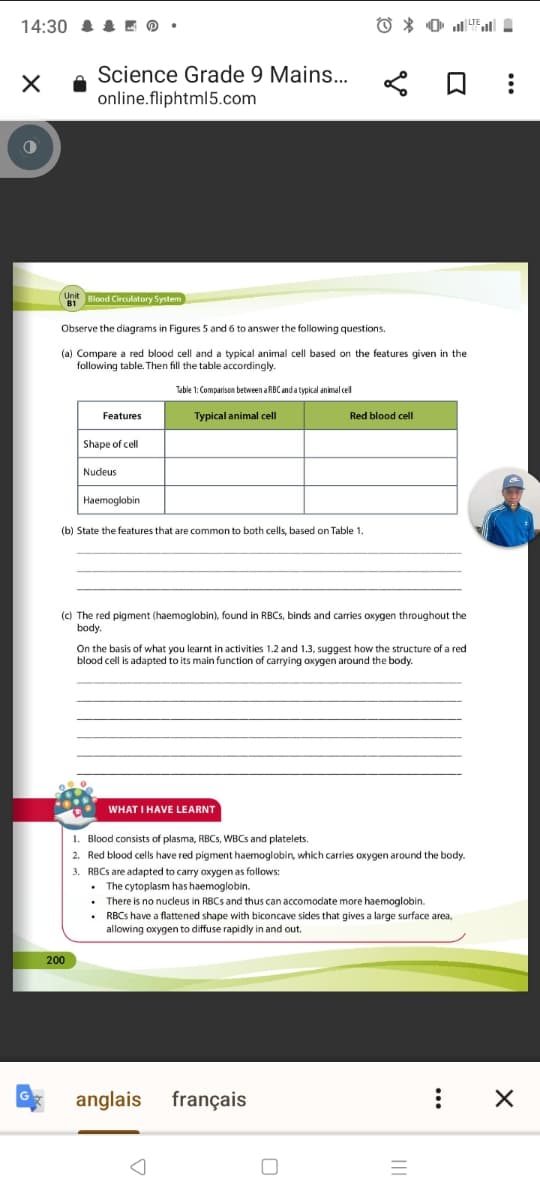Observe the diagrams in Figures 5 and 6 to answer the following questions. (a) Compare a red blood cell and a typical animal cell based on the features given in the following table. Then fill the table accordingly. Table 1: Comparison between a RBC and a typical animal cell Typical animal cell Features Shape of cell 200 Nudeus Haemoglobin Red blood cell (b) State the features that are common to both cells, based on Table 1. (c) The red pigment (haemoglobin), found in RBCs, binds and carries oxygen throughout the body. On the basis of what you learnt in activities 1.2 and 1.3, suggest how the structure of a red blood cell is adapted to its main function of carrying oxygen around the body. WHAT I HAVE LEARNT 1. Blood consists of plasma, RBCs, WBCs and platelets. 2. Red blood cells have red pigment haemoglobin, which carries oxygen around the body. 3. RBCs are adapted to carry oxygen as follows: . The cytoplasm has haemoglobin. . There is no nucleus in RBCS and thus can accomodate more haemoglobin. RBCs have a flattened shape with biconcave sides that gives a large surface area, allowing oxygen to diffuse rapidly in and out.
Observe the diagrams in Figures 5 and 6 to answer the following questions. (a) Compare a red blood cell and a typical animal cell based on the features given in the following table. Then fill the table accordingly. Table 1: Comparison between a RBC and a typical animal cell Typical animal cell Features Shape of cell 200 Nudeus Haemoglobin Red blood cell (b) State the features that are common to both cells, based on Table 1. (c) The red pigment (haemoglobin), found in RBCs, binds and carries oxygen throughout the body. On the basis of what you learnt in activities 1.2 and 1.3, suggest how the structure of a red blood cell is adapted to its main function of carrying oxygen around the body. WHAT I HAVE LEARNT 1. Blood consists of plasma, RBCs, WBCs and platelets. 2. Red blood cells have red pigment haemoglobin, which carries oxygen around the body. 3. RBCs are adapted to carry oxygen as follows: . The cytoplasm has haemoglobin. . There is no nucleus in RBCS and thus can accomodate more haemoglobin. RBCs have a flattened shape with biconcave sides that gives a large surface area, allowing oxygen to diffuse rapidly in and out.
Chapter23: Medications Used For Cardiovascular System Disorders
Section: Chapter Questions
Problem 21RQ
Related questions
Question

Transcribed Image Text:14:30 •
X
O
Science Grade 9 Mains...
online.fliphtml5.com
Unit Blood Circulatory System
Observe the diagrams in Figures 5 and 6 to answer the following questions.
(a) Compare a red blood cell and a typical animal cell based on the features given in the
following table. Then fill the table accordingly.
Table 1: Comparison between a RBC and a typical animal cell
Typical animal cell
Features
Shape of cell
200
Nudeus
Haemoglobin
(b) State the features that are common to both cells, based on Table 1.
© I
O Full
L
(c) The red pigment (haemoglobin), found in RBCs, binds and carries oxygen throughout the
body.
Red blood cell
anglais français
On the basis of what you learnt in activities 1.2 and 1.3, suggest how the structure of a red
blood cell is adapted to its main function of carrying oxygen around the body.
0
WHAT I HAVE LEARNT
1. Blood consists of plasma, RBCs, WBCs and platelets.
2. Red blood cells have red pigment haemoglobin, which carries oxygen around the body.
3. RBCs are adapted to carry oxygen as follows:
. The cytoplasm has haemoglobin.
There is no nucleus in RBCS and thus can accomodate more haemoglobin.
•
RBCs have a flattened shape with biconcave sides that gives a large surface area,
allowing oxygen to diffuse rapidly in and out.
:
:
X
Expert Solution
This question has been solved!
Explore an expertly crafted, step-by-step solution for a thorough understanding of key concepts.
Step by step
Solved in 3 steps

Knowledge Booster
Learn more about
Need a deep-dive on the concept behind this application? Look no further. Learn more about this topic, biology and related others by exploring similar questions and additional content below.Recommended textbooks for you







Cardiopulmonary Anatomy & Physiology
Biology
ISBN:
9781337794909
Author:
Des Jardins, Terry.
Publisher:
Cengage Learning,

